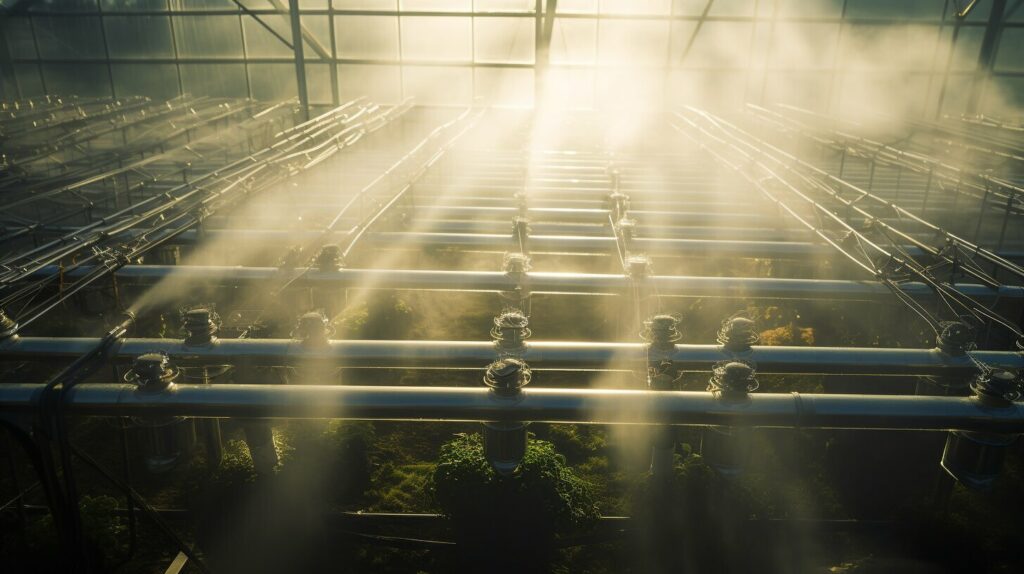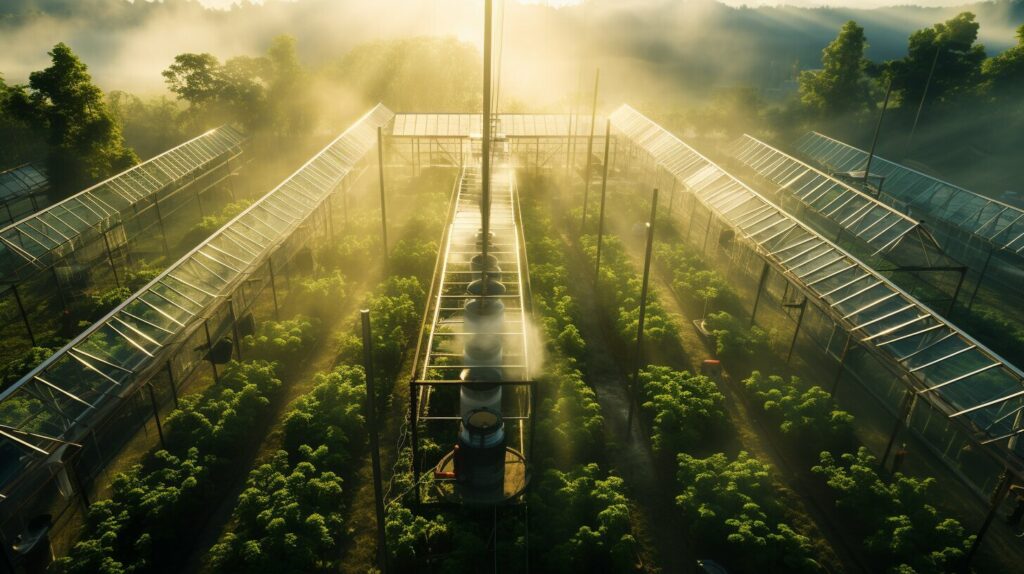Greenhouse Irrigation: Essential Tips for Efficient Watering
Greenhouses are an excellent tool for growing plants year-round, but they require proper care to achieve optimal results. One crucial aspect of greenhouse maintenance is irrigation. Without adequate watering, plants can suffer from stress, disease, and even death.
Greenhouse irrigation involves supplying plants with the right amount of water at the right time. It requires a delicate balance between providing enough water to meet the plants’ needs while avoiding excess that can lead to root rot, fungal growth, and nutrient loss.
A greenhouse irrigation system can help achieve efficient water usage. It is a system that automates the watering process, ensuring plants receive the right amount of water at the right time. There are several types of greenhouse watering systems to choose from, each with its advantages and disadvantages.
In this section, we will discuss various types of watering systems suitable for greenhouses, the benefits of using a greenhouse irrigation system, and how to achieve efficient water usage. By the end of this section, you will gain a better understanding of the importance of greenhouse irrigation and the available options for achieving optimal plant growth.
Types of Greenhouse Irrigation Systems
When it comes to greenhouse irrigation, there are various types of watering systems to choose from. Each system has its benefits and drawbacks, so it’s important to consider the specific needs of your greenhouse and plants when making a decision. In this section, we’ll explore some of the most common greenhouse irrigation systems.
Greenhouse Sprinkler
One type of greenhouse irrigation system is the sprinkler system, which distributes water through overhead sprinklers. Sprinklers are a popular choice for greenhouse owners because they are relatively inexpensive and easy to install. Additionally, they can cover a large area at once and are effective for crops that require a lot of water, such as tomatoes and cucumbers. However, sprinklers can also waste water due to overspray and evaporation, and they may not be suitable for plants that are sensitive to getting wet leaves.

Greenhouse Watering System with Timer
A watering system with a timer is another popular choice for greenhouse owners. With this system, water is delivered through drip lines or micro-sprinklers, and a timer is used to control the frequency and duration of watering. This helps to ensure that plants receive the right amount of water at the right time, and can be particularly useful for plants that have specific water requirements. Additionally, a timer can help to conserve water and reduce water waste. However, this type of system can be more expensive to install and may require more maintenance than other systems.
Automatic Watering System for Greenhouse
Another option for greenhouse irrigation is an automatic watering system. This system delivers water through drip lines or sprayers, and is controlled by a computerized system that adjusts watering frequency and duration based on factors such as plant type and weather conditions. An automatic watering system can help to conserve water by delivering water only when it is needed, and can be particularly useful for large-scale greenhouses where manual watering may not be practical. However, this type of system can be expensive to install and may require more maintenance than other systems.
Ultimately, the type of greenhouse irrigation system you choose will depend on your specific needs and budget. Consider the water requirements of your plants, the size of your greenhouse, and your preferred level of automation when making a decision.
Overhead Irrigation vs. Drip Irrigation
The choice between overhead irrigation and drip irrigation is an important one for greenhouse owners. Each method has its advantages and drawbacks, and the decision should be based on factors such as water efficiency, disease prevention, and plant-specific water requirements.
Overhead Irrigation

Overhead irrigation involves spraying water over the plants from above, using either a sprinkler or misting system. This method is useful for watering a large area of plants quickly and efficiently, and it can help to maintain humidity levels in the greenhouse. However, it can lead to water waste through evaporation, and it may increase the risk of disease spreading among plants. Overhead irrigation is best suited for plants that require a high degree of moisture, such as leafy greens and herbs.
Drip Irrigation
Drip irrigation involves delivering water directly to the roots of the plants through a network of tubes and emitters. This method is highly efficient in terms of water usage and can help to prevent disease by minimizing water contact with plant foliage. It also allows for precise control over watering, which can be especially beneficial for plants with specific water requirements. However, drip irrigation systems can be more complex to install and maintain, and they may be less effective for plants that require high levels of moisture.
When deciding between overhead and drip irrigation, it is important to consider the specific needs of the plants being grown and the overall goals of the greenhouse operation. Some greenhouse owners may choose to use a combination of both methods, using overhead irrigation for certain areas and drip irrigation for others. Ultimately, the decision should be based on achieving optimal plant health and water efficiency.
Commercial Greenhouse Irrigation Systems
Large-scale commercial greenhouse operations have unique irrigation needs that require specialized systems to manage water usage effectively. Water conservation is a high priority for commercial growers, as water scarcity and rising costs can significantly impact their bottom line. At the same time, it’s crucial to maintain optimal plant health and growth to maximize productivity and profitability.
One effective irrigation system for commercial greenhouses is the drip irrigation system. This system delivers precise amounts of water to individual plants’ roots, reducing water waste and minimizing the risk of disease. Drip irrigation also allows growers to customize water delivery based on specific plant needs, resulting in healthier and more productive plants.
Another option for large-scale greenhouse operations is the ebb and flow irrigation system, which uses a series of flood tables to deliver water to plants. This method can be particularly advantageous for hydroponic systems, allowing for efficient nutrient delivery and a controlled growing environment. However, it requires careful monitoring to prevent water waste and potential water-borne disease outbreaks.
Water Management Strategies
Effective water management is critical for commercial greenhouse operations. Some strategies to consider include:
- Collecting rainwater to reduce reliance on municipal water sources.
- Implementing a closed-loop irrigation system that recirculates and filters water for reuse.
- Incorporating soil moisture sensors and weather data to fine-tune irrigation schedules and avoid overwatering.
By combining these strategies with effective irrigation systems, commercial greenhouse growers can achieve optimal water usage and plant health while reducing operational costs.

Image description: A large commercial greenhouse with an irrigation system in place, demonstrating the scale of operations for commercial growers.
Conclusion
In conclusion, greenhouse irrigation plays a pivotal role in optimal plant growth and efficient water distribution. From DIY subirrigation methods to complex automated systems, each system has its advantages and limitations. One of the vital decisions involves choosing between automated vs manual irrigation. Automated irrigation systems, which may include drip systems and nutrient film techniques, provide a high level of control but may require a higher initial investment. On the other hand, manual irrigation methods like hand watering or using a garden hose are less expensive but demand more labor.
When it comes to irrigation system design, multiple factors must be considered. These include water pressure, the choice between solar-powered irrigation systems or traditional electricity-based setups, and the types of irrigation supplies needed, such as PVC pipes, poly tubing, or soaker hoses. For pest control, some prefer overhead watering methods, although this may risk waterborne diseases.
In a bid to save water and promote sustainability, systems that reuse water are becoming increasingly popular. These systems are not only eco-friendly but also cost-effective in the long run. Choices in growing media or growing mediums can also affect the effectiveness of your irrigation system, and options like capillary mats and cold frames can be considered for specific needs.
Therefore, a well-designed irrigation system, whether automated or manual, helps your flowering plants or any other types of plants in your greenhouse thrive, while ensuring efficient use of irrigation water and energy.
FAQ
Q: What is the role of a system designer in greenhouse irrigation?
A: A system designer specializes in customizing irrigation systems based on the specific needs of your greenhouse. They take into account factors such as greenhouse size, types of plants, and water conservation goals to design a system that’s efficient and effective.
Q: How do automated irrigation systems differ from manual irrigation in terms of water distribution?
A: Automated irrigation systems, which may include drip systems and nutrient film techniques, offer more precise water distribution directly to the plant roots. Manual irrigation methods like hand watering may not offer uniform distribution and often require more effort.
Q: Can you elaborate on the irrigation supplies commonly used in greenhouses?
A: Common irrigation supplies include PVC pipes, poly tubing for drip systems, sprinkler head risers for overhead sprinkler systems, and soaker hoses. Each serves a unique purpose and is essential for the efficient functioning of an irrigation system.
Q: How do solar-powered irrigation systems work and what are their benefits?
A: Solar-powered irrigation systems use solar panels to generate energy that powers the irrigation setup. They are particularly beneficial in regions with abundant sunlight and help in reducing energy costs, thereby making the system more sustainable.
Q: What are the pros and cons of using different growing mediums in irrigation?
A: Different growing mediums have varying water retention capacities. Some, like peat moss, hold water well but may require frequent checks to avoid overwatering. Others, such as perlite, offer better drainage and are better suited for systems like drip irrigation or nutrient film techniques.
Q: Are greenhouse sprinkler systems suitable for all types of plants?
A: Greenhouse sprinkler systems generally offer uniform water coverage, making them suitable for a wide range of plants. However, they may not be ideal for plants that are sensitive to moisture on their leaves or those susceptible to waterborne diseases.
Q: How can the reuse of water contribute to sustainability in greenhouse irrigation?
A: Systems that reuse water collect runoff and filter it for reuse, significantly reducing water wastage. This is not only eco-friendly but also lowers long-term operational costs, contributing to a more sustainable greenhouse operation.




